-
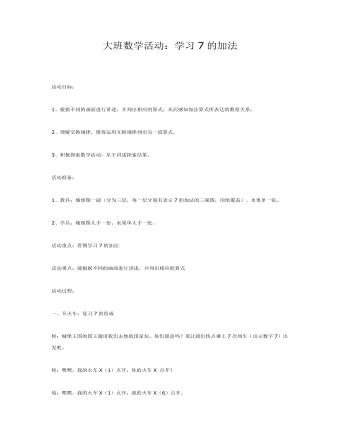
大班数学活动:学习7的加法课件教案
2、理解交换规律,懂得运用互换规律列出另一道算式。3、积极探索数学活动,乐于讲述探索结果。活动准备:1、教具:城堡图一副(分为三层,每一层分别有表示7的加法的三副图,用纸覆盖)、水果单一张。2、学具:城堡图人手一份、水果单人手一张。活动重点:看图学习7的加法活动难点:能根据不同的画面进行讲述,并列出相应的算式活动过程:一、开火车:复习7的组成师:城堡王国的国王邀请我们去他的国家玩,你们愿意吗?那让我们快点乘上7次列车(出示数字7)出发吧。师:嘿嘿,我的火车X(1)点开,你的火车X 点开?幼:嘿嘿,我的火车X(1)点开,我的火车X(6)点开。

大班数学游戏教案:城堡夺旗(8的分合法)
准备:数字卡 棋盘 不同颜色的棋子 旋转六面体 各色旗 扑克牌 玩法:每组5名幼儿,一幅棋盘,每位幼儿一套1——7的扑克牌,每名幼儿持一粒不同颜色的棋子,将各自的棋子放在起点,按照自己的标志次序轮流掷旋转六面体,掷出数字几,就向前走几步,如果走到没有图案的格内,就让下一位幼儿掷旋转六面体;如果走到有图案的格子内,就大声说出图案的数量,并向其他幼儿提问该数字和哪一个数字合起来是8,然后与同伴一起从自己的数字卡中拿出相应的数字卡,拿对的幼儿向前走一步,拿错的幼儿原地不动,看谁先走到终点,谁就在城堡的最底层插一面与自己棋子颜色相同的彩旗。游戏反复进行,谁的彩旗第一个到达城堡的顶端,谁就取得胜利。
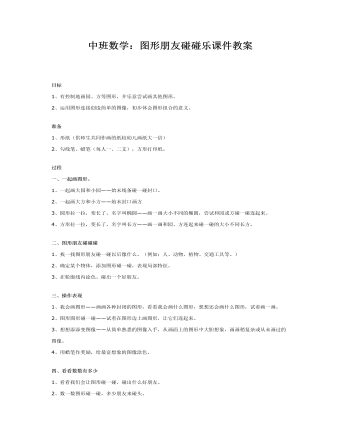
中班数学:图形朋友碰碰乐课件教案
2、运用图形连接创造简单的图像,初步体会图形组合的意义。准备1、形纸(供师生共同作画的纸较幼儿画纸大一倍)2、勾线笔、蜡笔(每人一、二支),方形打印纸。过程一、一起画图形。1、一起画大园和小园——始末线条碰一碰封口。2、一起画大方和小方——始末封口画方3、圆形拉一拉,变长了,名字叫椭圆——画一画大小不同的椭圆,尝试和园或方碰一碰连起来。4、方形拉一拉,变长了,名字叫长方——画一画和园、方连起来碰一碰的大小不同长方。二、图形朋友碰碰碰1、找一找图形朋友碰一碰以后像什么。(例如:人、动物、植物、交通工具等。)2、确定某个物体,添加图形碰一碰,表现局部特征。3、在轮廓线内涂色。碰出一个好朋友。
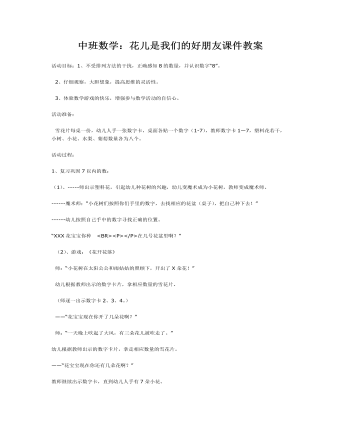
中班数学:花儿是我们的好朋友课件教案
2、仔细观察,大胆想象,提高思维的灵活性。 3、体验数学游戏的快乐,增强参与数学活动的自信心。活动准备: 雪花片每桌一份,幼儿人手一张数字卡,桌面各贴一个数字(1-7),教师数字卡1—7,塑料花若干,小树、小花、水梨、葡萄数量各为八个。活动过程:1、复习巩固7以内的数:(1)、-----师出示塑料花,引起幼儿种花树的兴趣,幼儿变魔术成为小花树,教师变成魔术师。------魔术师:“小花树们按照你们手里的数字,去找相应的花盆(桌子),把自己种下去!”------幼儿按照自己手中的数字寻找正确的位置。“XXX花宝宝你种 在几号花盆里啊?” (2)、游戏:《花开花落》 师:“小花树在太阳公公和雨姑姑的照顾下,开出了X朵花!” 幼儿根据教师出示的数字卡片,拿相应数量的雪花片。 (师逐一出示数字卡2、3、4。)
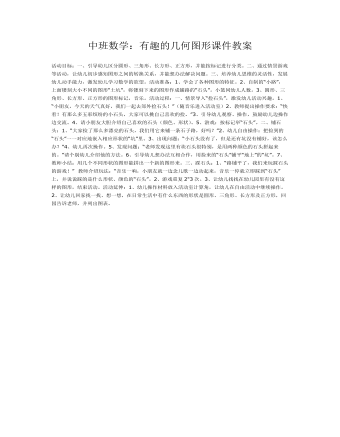
中班数学:有趣的几何图形课件教案
二、通过情景游戏等活动,让幼儿初步感知图形之间的转换关系,并能想办法解决问题。三、培养幼儿思维的灵活性,发展幼儿动手能力,激发幼儿学习数学的欲望。活动准备:1、学会了各种图形的特征。2、自制的“小路”,上面镂刻大小不同的图形“土坑”,将镂刻下来的图形作成铺路的“石头”。小篮同幼儿人数。3、圆形、三角形、长方形、正方形的图形标记,音乐。活动过程:一、情景导入“捡石头”,激发幼儿活动兴趣。1、“小朋友,今天的天气真好,我们一起去郊外捡石头!”(随音乐进入活动室)2、教师提出操作要求:“快看!有那么多五彩缤纷的小石头,大家可以挑自己喜欢的捡。”3、引导幼儿观察、操作,鼓励幼儿边操作边交流。4、请小朋友大胆介绍自己喜欢的石头(颜色、形状)。5、游戏:按标记举“石头”。
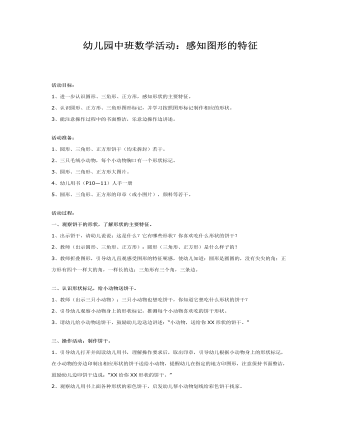
中班数学活动:感知图形的特征课件教案
2、认识圆形、正方形、三角形图形标记,并学习按照图形标记制作相应的形状。 3、能注意操作过程中的书面整洁,乐意边操作边讲述。 活动准备: 1、圆形、三角形、正方形饼干(均未拆封)若干。 2、三只毛绒小动物,每个小动物胸口有一个形状标记。 3、圆形、三角形、正方形大图片。 4、幼儿用书(P10—11)人手一册 5、圆形、三角形、正方形的印章(或小图片),颜料等若干。 活动过程: 一、观察饼干的形状,了解形状的主要特征。1、出示饼干,请幼儿说说:这是什么?它有哪些形状?你喜欢吃什么形状的饼干? 2、教师(出示圆形、三角形、正方形):圆形(三角形、正方形)是什么样子的? 3、教师折叠图形,引导幼儿直观感受图形的特征呢感,使幼儿知道:圆形是圆圆的,没有尖尖的角;正方形有四个一样大的角,一样长的边;三角形有三个角,三条边。
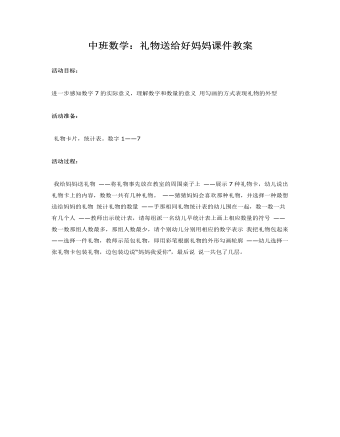
中班数学:礼物送给好妈妈课件教案
活动准备: 礼物卡片,统计表。数字1——7 活动过程: 我给妈妈送礼物 ——将礼物事先放在教室的周围桌子上 ——展示7种礼物卡,幼儿说出礼物卡上的内容,数数一共有几种礼物。 ——猜猜妈妈会喜欢那种礼物,并选择一种最想送给妈妈的礼物统计礼物的数量 ——手那相同礼物统计表的幼儿围在一起,数一数一共有几个人 ——教师出示统计表,请每组派一名幼儿早统计表上画上相应数量的符号 ——数一数那组人数最多,那组人数最少,
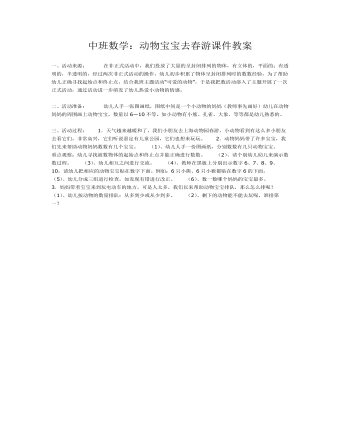
中班数学:动物宝宝去春游课件教案
二、活动准备: 幼儿人手一张图画纸,图纸中间是一个小动物的妈妈(教师事先画好)幼儿在动物妈妈的周围画上动物宝宝,数量以6—10不等。如小动物有小熊、孔雀、大象、等等都是幼儿熟悉的。三、活动过程: 1.天气越来越暖和了,我们小朋友去上海动物园春游,小动物看到有这么多小朋友去看它们,非常高兴,它们听说嘉定有儿童公园,它们也想来玩玩。 2.动物妈妈带了许多宝宝,我们先来帮助动物妈妈数数有几个宝宝。 (1)、幼儿人手一份图画纸,分别数数有几只动物宝宝。 重点观察:幼儿寻找被数物体的起始点和终止点并能正确进行数数。
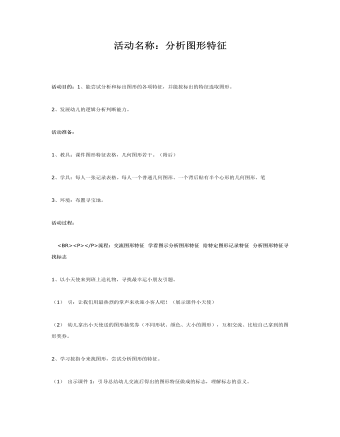
分析图形特征课件教案(大班数学)
2、发展幼儿的逻辑分析判断能力。活动准备:1、教具:课件图形特征表格,几何图形若干。(附后)2、学具:每人一张记录表格。每人一个普通几何图形、一个背后贴有半个心形的几何图形、笔3、环境:布置寻宝地。活动过程: 流程:交流图形特征 学看图示分析图形特征 给特定图形记录特征 分析图形特征寻找标志1、以小天使来到班上送礼物,寻找最幸运小朋友引题。(1)引:让我们用最热烈的掌声来欢迎小客人吧!(展示课件小天使)
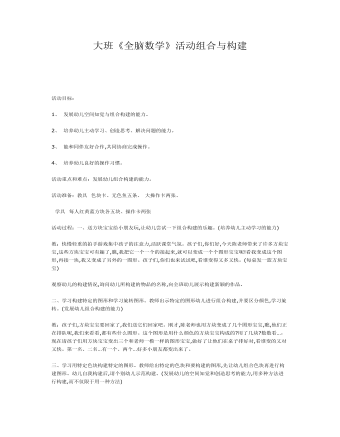
大班全脑数学:组合与构建课件教案
2、 培养幼儿主动学习、创造思考、解决问题的能力。3、 能和同伴友好合作,共同协商完成操作。4、 培养幼儿良好的操作习惯。活动重点和难点:发展幼儿组合构建的能力。活动准备:教具 色块卡、无色鱼五条、大操作卡两张、 学具 每人红黄蓝方块各五块、操作卡两张活动过程:一、送方块宝宝给小朋友玩,让幼儿尝试一下组合构建的乐趣。(培养幼儿主动学习的能力)教:快慢轻重的拍手游戏集中孩子的注意力,活跃课堂气氛。孩子们,你们好,今天陈老师带来了许多方块宝宝,这些方块宝宝可有趣了,瞧,我把它一个一个的接起来,就可以变成一个个图形宝宝呢!看我变成这个图形,再接一块,我又变成了另外的一图形。孩子们,你们也来试试吧,看谁变得又多又快。(每桌发一篮方块宝宝)观察幼儿的构建情况,询问幼儿所构建的物品的名称,向全班幼儿展示构建新颖的作品。
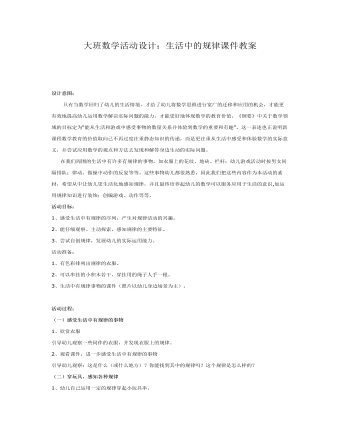
大班数学活动设计:生活中的规律课件教案
活动目标:1、感受生活中有规律的序列,产生对规律活动的兴趣。2、能仔细观察、主动探索,感知规律的主要特征。3、尝试自创规律,发展幼儿的实际运用能力。活动准备:1、有色彩排列出规律的衣服。2、可以串挂的小积木若干,穿挂用的绳子人手一根。3、生活中有规律事物的课件(照片以幼儿身边场景为主)。
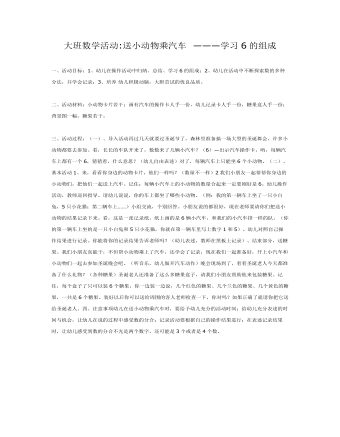
大班数学:送小动物乘汽车课件教案
二、活动材料:小动物卡片若干;画有汽车的操作卡人手一份,幼儿记录卡人手一份,糖果盒人手一份;背景图一幅,糖果若干。 三、活动过程:(一)、导入活动再过几天就要过圣诞节了,森林里准备搞一场大型的圣诞舞会,许多小动物都要去参加。看,长长的车队开来了,数数来了几辆小汽车?(6)—出示汽车操作卡。哟,每辆汽车上都有一个6,猜猜看,什么意思?(幼儿自由表述)对了,每辆汽车上只能坐6个小动物。(二)、基本活动1、来,看看你身边的动物卡片,他们一样吗?(数量不一样)2我们小朋友一起帮帮你身边的小动物们,把他们一起送上汽车。记住:每辆小汽车上的小动物的数量合起来一定要刚好是6。幼儿操作活动,教师巡回指导。请幼儿说说,你的车上都坐了哪些小动物。(例:我的第一辆车上坐了一只小白兔,5只小花猫;第二辆车上……)小组交流,个别回答。小朋友说的都很好,现在老师要请你们把送小动物的结果记录下来。看,这是一张记录纸,纸上画的是6辆小汽车,和我们的小汽车排一样的队,(你的第一辆车上坐的是一只小白兔和5只小花猫,你就在第一辆车里写上数字1和5)。
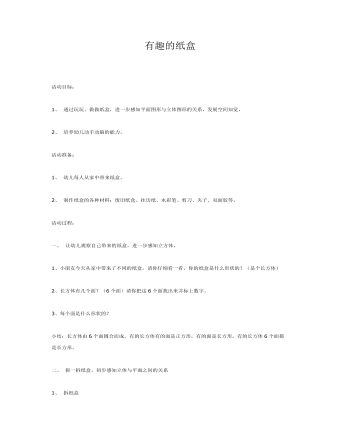
大班数学活动有趣的纸盒课件教案
2、 培养幼儿动手动脑的能力。活动准备:1、 幼儿每人从家中带来纸盒。2、 制作纸盒的各种材料:废旧纸盒、挂历纸、水彩笔、剪刀、夹子、双面胶等。活动过程:一、 让幼儿观察自己带来的纸盒,进一步感知立方体。1、小朋友今天从家中带来了不同的纸盒,请你仔细看一看,你的纸盒是什么形状的?(是个长方体)
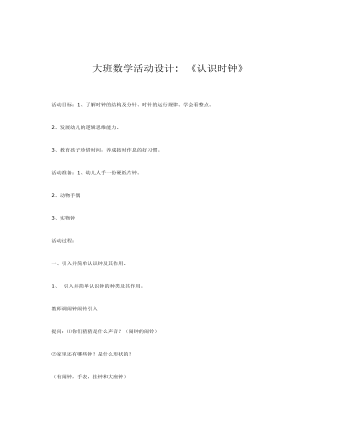
大班数学活动设计《认识时钟》课件教案
2、发展幼儿的逻辑思维能力。3、教育孩子珍惜时间,养成按时作息的好习惯。活动准备:1、幼儿人手一份硬纸片钟。2、动物手偶3、实物钟活动过程:一、引入并简单认识钟及其作用。1、 引入并简单认识钟的种类及其作用。教师调闹钟闹铃引入提问:⑴你们猜猜是什么声音?(闹钟的闹铃)⑵家里还有哪些钟?是什么形状的?(有闹钟,手表,挂钟和大座钟)⑶钟有什么作用?(钟不停的走,告诉人们几点了,人们就按照时钟上的时间进行学习休息)2、简单认识钟面。教师:今天老师也带来了一个钟,看看它是什么形状的?(圆形)请你仔细观察钟面上有什么?总结:有两根针和12个数字。提问:⑴这两根针有什么不同?(长度不同)教师:他们都有自己的名字,长的叫分针,短的叫时针。我们在看看数字,提问:⑵正上面的是数字多少?(12)⑶正下面的是数字多少?(6)二、由时针、分针赛跑,引导幼儿感知时针、分针的运转规律。教师:今天呀,时针和分针要进行依次跑步比赛,现在他们都摘在数字12的起跑线上了。请你们猜猜谁回赢?好,比赛就要开始了,预备— 开始!(教师操作钟表)提问:⑴谁跑的快?(分针)议论:分针和时针跑的时候,他们之间有什么秘密呢?教师反复操作。总结:分钟走一圈,时钟走一格,这就是一小时。
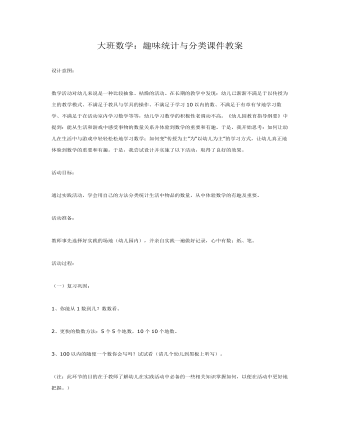
大班数学:趣味统计与分类课件教案
活动目标:通过实践活动,学会用自己的方法分类统计生活中物品的数量,从中体验数学的有趣及重要。活动准备:教师事先选择好实践的场地(幼儿园内),并亲自实践一遍做好记录,心中有数;纸、笔。活动过程:(一)复习巩固:1、你能从1数到几?数数看。2、更快的数数方法:5个5个地数,10个10个地数。3、100以内的随便一个数你会写吗?试试看(请几个幼儿到黑板上听写)。(注:此环节的目的在于教师了解幼儿在实践活动中必备的一些相关知识掌握如何,以便在活动中更好地把握。)(二)联 系生活:1、在生活中,你碰到什么东西要用数来数?举例子。2、在幼儿园里也藏了许多数,请小朋友们说说。3、用什么方法统计方便?(每5个或10个记录一次,然后5个5个或10个10个地数;列表统计等)
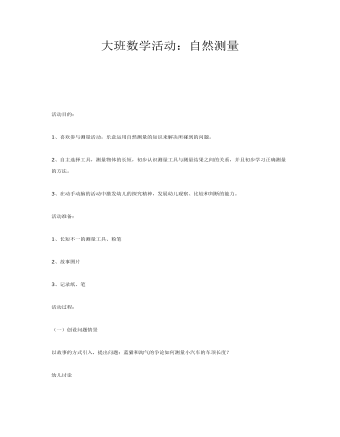
大班数学活动:自然测量课件教案
2、自主选择工具,测量物体的长短,初步认识测量工具与测量结果之间的关系,并且初步学习正确测量的方法。3、在动手动脑的活动中激发幼儿的探究精神,发展幼儿观察、比较和判断的能力。活动准备:1、长短不一的测量工具、粉笔2、故事图片3、记录纸、笔
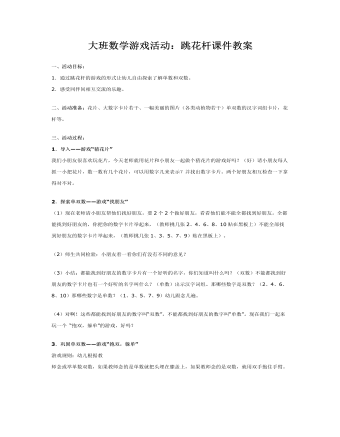
大班数学游戏活动:跳花杆课件教案
2.感受同伴间相互交流的乐趣。二、活动准备:花片、大数字卡片若干、一幅美丽的图片(各类动植物若干)单双数的汉字词组卡片,花杆等。三、活动过程:1.导入——游戏“猜花片”我们小朋友很喜欢玩花片,今天老师就用花片和小朋友一起做个猜花片的游戏好吗?(好)请小朋友每人抓一小把花片,数一数有几个花片,可以用数字几来表示?并找出数字卡片。两个好朋友相互检查一下拿得对不对。
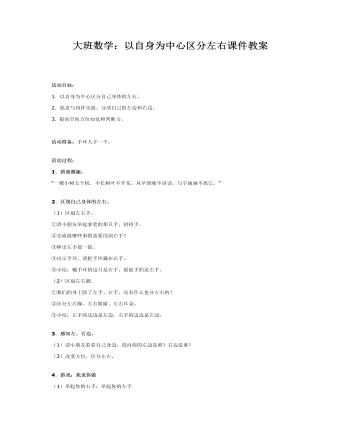
大班数学:以自身为中心区分左右课件教案
2.愿意与同伴交流,分清自己的左边和右边。 3. 提高空间方位知觉和判断力。 活动准备:手环人手一个。活动过程: 1.猜谜激趣。 “一棵小树五个杈,不长树叶不开花。从早到晚不讲话,写字画画不离它。”2.区别自己身体的左右。 (1)区别左右手。 ①请小朋友举起拿笔的那只手,招招手。 ②交流做哪些事情需要用到右手? ③伸出左手摇一摇。 ④出示手环,请把手环戴在右手。 ⑤小结:戴手环的这只是右手。摇摇手的是左手。

大班数学活动:斗智旅行棋课件教案
2、 培养幼儿团结、协作、机智的品质。活动准备:自制大棋谱一张、骰子、操作卡、笔、投影仪等活动过程:一、引起兴趣小朋友们都爱下象棋,那你们下过旅行棋吗?我们一起来下棋,来比赛,好吗?二、讲解示范行走规则幼儿分组,为COCO队和DUDU队。掷骰子,按点子数前行。每过一个关口,必须答出其中的题目,答对了继续前进,答错了则后退。两队轮流进行,依次闯过各个关口。看哪一队先到目的地。
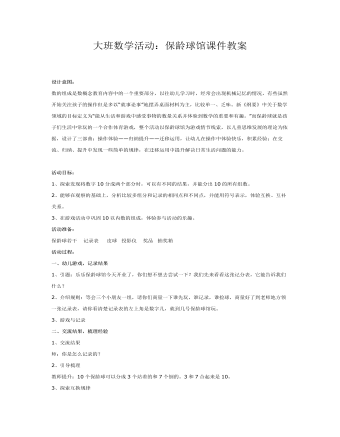
大班数学活动:保龄球馆课件教案
活动目标:1、探索发现将数字10分成两个部分时,可以有不同的结果,并能分出10的所有组数。2、能够在观察的基础上,分析比较多组分和记录的相同点和不同点,并能用符号表示,体验互换、互补关系。3、在游戏活动中巩固10以内数的组成,体验参与活动的乐趣。 活动准备:保龄球若干 记录表 皮球 投影仪 奖品 抽奖箱 活动过程:一、幼儿游戏,记录结果1、引题:乐乐保龄球馆今天开业了,你们想不想去尝试一下?我们先来看看这张记分表,它能告诉我们什么?2、介绍规则:等会三个小朋友一组,请你们商量一下谁先玩,谁记录,谁捡球,商量好了到老师地方领一张记录表,请你看清楚记录表的左上角是数字几,就到几号保龄球馆玩。3、游戏与记录

